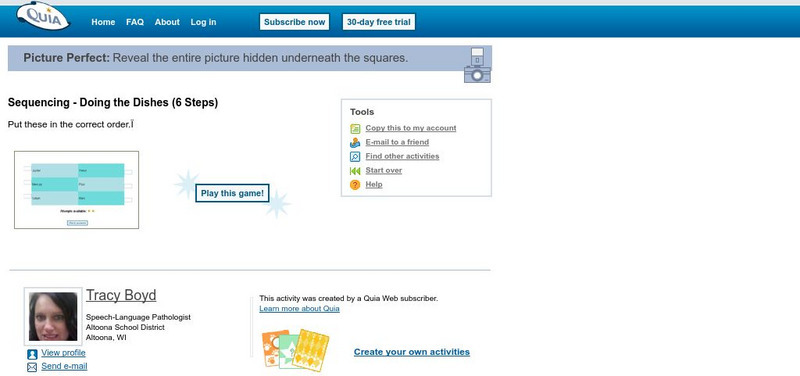Curated OER
Marking Time
Two narrative excerpts tell the same story from different points of view. In the first excerpt (first person), sequencing words and phrases are bolded and learners write down what the bold type does. The second excerpt is in third...
Scholastic
What Happened Next? (Grades K-4)
Explore the structure of narrative writing with this fun, collaborative activity. Start by reading aloud a short story, asking small groups of learners to fill in key events on a large story board prepared on the class whiteboard....
Curated OER
Goldilocks and the Three Bears
Explore storyboards with your pre-reader using the familiar story "Goldilocks and the Three Bears." They look at pictures as you read the captions in a comic book style. At the end, they try to finish the story based on a resolution...
Curated OER
A Chronology of the Holocaust
A straightforward chronology of the Holocaust lists events from 1930 to 1945. Connects to a page with links to extensive resources and information about the Holocaust. Use as a resource for student inquiry into the Holocaust.
Curated OER
ELD Lesson Plan: Courage
What is true courage? Your class can explore the answer with these three Houghton-Mifflin stories ("Hatchet," "Passage to Freedom," "Climb or Die," and "The True Confessions of Charlotte Doyle"), which feature courageous characters and...
Guam Community College
Joseph Had a Little Overcoat
Spruce up a class reading of the children's book Joseph Had a Little Overcoat by Simms Taback with this fun series of activities. Starting with a list of reading comprehension questions and key vocabulary to address during a teacher...
Curated OER
Goldilocks Live!!!
Study story elements with your young learners. Read Goldilocks and the Three Bears and discuss the order of events by making a story panel out of butcher paper. Sentences are given as suggestions for the panel, though you may...
Curated OER
How Bear Lost His Tale: Storytelling
In this storytelling lesson, children practice re-telling the story of "How Bear Lost His Tale", review and write out the story sequence, and learn about homophones like tail/tale, sail/sale, etc. Extension activities for various content...
Curated OER
Gingerbread Man
In this story sequencing worksheet, students practice their story-telling skills. Students color and cut out four parts of the story about the gingerbread man and put them in order.
Curated OER
THE LITTLE RED HEN - A TALE OF COOPERATION
Students explore how much pleasure reading can bring, explain the concept of "story sequence", "re-tell" a story through art, and read other folktales.
Curated OER
Teaching Guide: Can You Make a Piggy Giggle?
Students explore the book Can You Make a Piggy Giggle?. In this language arts lesson, students focus on a variety of aspects within the book. Students study the illustrations, listen for rhymes, and attempt the tongue twisters in the text.
Curated OER
Hickory Dickory Dock
Students use the Hickory Dickory Dock nursery rhyme to learn about rhyme, telling time, and preposition use. In this nursery rhyme instructional activity, students read the nursery rhyme daily and complete a Mother Goose quiz. Students...
Curated OER
Retelling the Main Event in Sequence
Students identify the key events in a fiction book. In this literacy lesson plan, students read the book Harry and the Lady Next Door and work in pairs to discuss the main events of each chapter to develop a short summary.
Curated OER
Chain of Events
In this sequence of events worksheet, students use the chain link graphic organizer to write the sequence of events in order. Students write the topic or draw a picture of it in the center space.
Curated OER
Writer's Workshop Mini-Lesson Plan- Story Sequencing
Students listen to a read aloud of Kevin Henkes, Owen, while listening for the beginning, middle, and end. They listen as the teacher describes the need for story organization and write down the story sequence. Finally, they create a...
Nazareth College
The Chocolate Touch
Third graders read and analyze chapter two of the book "The Chocolate Touch" by Patrick Skene Catling. They compare and contrast a box of chocolates with the chocolates in the book, and write the sequential steps of opening a box of...
Curated OER
Sequence Ladder
For this sequence of events worksheet, students complete the graphic organizer that lists the order of events for a story from first, next, then, and last.
Curated OER
Order Events
In this ordering events learning exercise, students solve the six word problems by finding the event that happens next in each situation. Students complete six ordering event problems.
Curated OER
Through the Day With Frog- Full Color Copy
In this reading worksheet, students create their own simple book by stapling together the 10 colorful pages. The story depicts children enjoying activities which begin with the letter F: fishing, football, floating. It ends with the...
Quia
Quia: Doing the Dishes
In this game, students are to read all nine steps to making homemade pizza and then number them in chronological order to reveal a hidden picture. Java is required.
ClassFlow
Class Flow: Number Line Squeeze
[Free Registration/Login Required] This flipchart is set up for students to practice their number recognition by playing Number-Line Squeeze. The students also get to review shape names and use less than and greater than phrases.






















